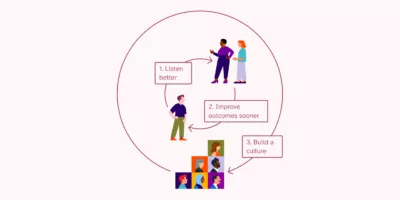17 Aug 2023
- Financial Services
The FCA says our products need to help customers achieve good outcomes, but what does that mean?

Since September, I’ve been submerged in the world of Consumer Duty. My whole world has revolved around the question: “Are products and services helping customers achieve good outcomes?”. But what does ‘good outcome’ mean?
-
Chloe Langan
Senior UX Consultant

The Financial Conduct Authority’s not-so-new Consumer Duty is all about ensuring that Financial Services organisations put customers at the heart of what they do. They must actively avoid causing harm and ensure that their customers achieve good outcomes.
But what does ‘good outcome’ mean?
A good outcome for one person may be completely different to another. It could mean:
- Building your credit score so you can buy a house
- Reducing the stress of dealing with the finances of a deceased loved one
- Simply affording to put food on the table
Firms need to actively help customers achieve these ‘good outcomes’, but because they’re so different for different people’s circumstances, that makes it very subjective. And, if it’s subjective it’s hard for firms to prove to the FCA that they’re doing this. It’s all a bit messy.
As individuals within firms will be held personally accountable if these ‘good outcomes’ aren’t met, they are spending a lot of money trying to figure out if their customers are achieving them. Ultimately these outcomes need to underpin the culture of entire organisations to be sure that everything a company does is helping customers in a positive way. We will likely end up seeing entire strategies centred on these good outcomes.
And why is defining it so important?
The first step to proving to the FCA that you’re achieving ‘good outcomes’ is having a solid definition of what this means for your organisation. This will likely take the form of a set of good outcomes, specific to your firm and the area of financial services you work in.
Having a more prescriptive set of good outcomes that work for all of your customers somewhat contradicts the idea that everyone’s experiences are different. However, it does help to bridge the gap between the broad idea of ‘good outcomes’ and the unique outcomes each customer wants to achieve. In my eyes, it does this in three ways.
Firstly, they should make the Consumer Duty feel more tangible. With something more actionable to aim for, it helps to make the Consumer Duty easier to manage. It also proves to the FCA that you’ve thought carefully about what you’re aiming for.
Secondly, distilling what ‘good outcomes’ means to your organisation should enable you to better measure how well you’re helping your customers achieve them. Having a yardstick to measure against keeps things as objective as possible. Having more consistent ways of measuring means that you can better track your progress over time, and compare across your products to determine which ones need the most attention.
The third, and to me the most important, reason for having a distilled set of good outcomes is that it helps your employees to put themselves in the customers’ shoes. Whilst employees often have the customers’ best interests at heart, the curse of knowledge that comes with working in a Financial Services firm prevents them from being able to see things from a newbie’s perspective, or the perspective of someone who doesn’t think about finance 9-5 Monday to Friday.
You’ve probably already distilled what ‘good outcomes’ means for your firm, but are they being as effective as they should be and triggering a shift towards the Consumer Duty culture that the FCA talks about?
So, how can you define ‘good outcomes’ for your customers?
I hope by now you’re convinced that having a more defined set of ‘good outcomes’ is a useful thing. But where do you start?
These are my thoughts on what makes an effective set.
1. Make them memorable
First of all, I think outcomes should be memorable. They need to be statements that people across the business can keep in mind at all times. They need to be constantly asking themselves ‘Am I helping customers to be [this] or do [this]?’ so that the outcomes are easily embedded into the way employees think. To keep outcomes memorable, they need to be short. There should be no more than five in total. And they should evoke emotion. They need to help employees empathise with users in what they do, whilst being actionable so it’s clear how to make a difference.
2. Don’t allow exceptions
If the outcomes are going to be memorable, they also need to be strong and have no exceptions. They should work in all situations for all customers. If there are exceptions, people may think they can ignore them in certain circumstances, and before you know it they’ve been left by the wayside. Being customer-focused won’t get embedded into a company culture if employees think good outcomes are optional.
3. Make sure you can measure them
Thirdly, we need to be able to determine whether or not customers are achieving these outcomes. This means they need to be measurable. Emotion-based outcomes, such as ‘customers feel valued’, aren’t easy to measure. However, breaking down what this means on a more granular level will introduce ways that we can measure whether customers are achieving these outcomes, and make them more actionable for your employees. ‘Customers feel valued’ could be broken down further into statements such as ‘Customers feel like they are being listened to when interacting with contact centre staff’, for instance. We can also use leading indicators such as whether you’re putting measures in place to ensure you’re avoiding causing harm. Companies can use qualitative measures as well such as user research and testing as ways of gauging emotion too.
No business metrics allowed!
Finally, the outcomes themselves should be customer-focused. Steer clear from business metrics. Reduced numbers of support tickets and reduced time on calls don’t really evoke emotion or drive the need for change within your employees. It also may encourage non-customer-focussed ways of achieving these things; such as, not providing the contact number clearly on the web page as a way to reduce calls to a contact centre. This very evidently will not help to achieve good outcomes for customers, and could in some cases cause more harm.
Key takeaways
If you make your customer outcomes memorable and measurable, with no exceptions and no business metrics, your company will have defined some pretty effective ‘good customer outcomes’ to aim towards. From these, you should be able to better measure how well you’re meeting the Consumer Duty and simultaneously embed more customer-centric ways of thinking throughout your organisation.
All in all, lots of firms will be defining these outcomes in very different ways. Now we have passed July’s Consumer Duty deadline, it’s a great time to be evaluating whether or not the way you’ve defined customer outcomes is working as well as it should be, and if there are any changes you could be making to make them more effective. The FCA said that the Consumer Duty is an iterative process for everyone, and now there’s some breathing space after the deadline, it seems like a good time to reflect.
If there are any nuggets of information you’ve learnt from the way you’ve defined ‘good customer outcomes’, or any things that have worked well for you, let me know! At cxpartners, we’re currently building some thoughts on this and we’re keen to hear if you have any yourselves. Get in touch at chloe.langan@cxpartners.co.uk.
















